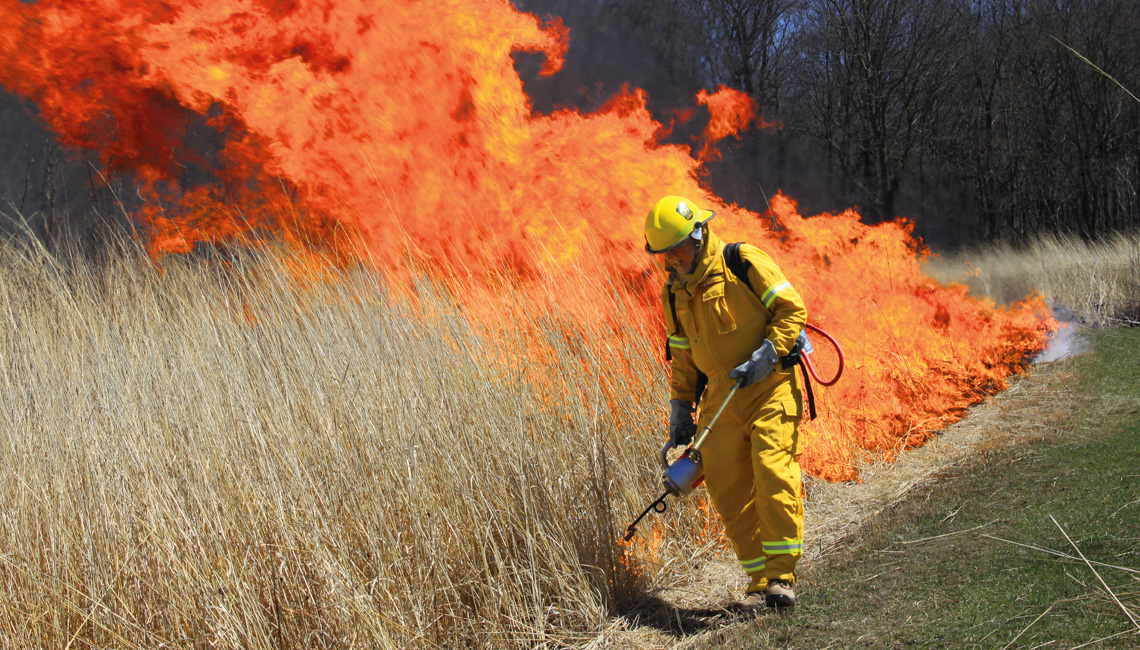Some natural resources conservation groups talk a good game. Others diligently and quietly go about their stated mission, making a decided difference in the out-of-doors year by year, decade after decade. Appalachia Ohio Alliance is definitely one of the latter.
“AOA is a private, nonprofit land conservancy organization, one of 1,700 in the United States,” says the alliance’s director, Steve Fleegal. “We cover most of central and southeast Ohio, with a focus on maintaining and improving water quality in four areas: the Scioto River, Big Darby Creek, the Hocking River, and Hocking Hills.”
It’s not the group’s only focus, of course; the group also works to preserve Native American sites, cultural heritage sites, historic farms, and geologic features across the region.
Ken Mettler, an AOA board member, surveys Bison Hollow Preserve in Hocking Hills.
To get a feel for AOA, I tagged along on one of the organization’s many annual educational events open to the public. The field trip attracted some 30 people to Cedar Bog Nature Preserve, a few miles south of Urbana. It’s the oldest nature preserve in the Buckeye State purchased with state funds (in 1942), and is owned, operated, and managed by the Ohio History Connection.
I had an added incentive for attending the leisurely guided hike along the mile-long boardwalk that spans the bog. I’d always wanted to photograph one of Ohio’s rarest and most spectacular spring wildflowers: the showy lady’s slipper orchid, which blooms in late May and early June. Cedar Bog did not disappoint.
Other annual AOA nature-based field trips — some 25 or so per year — include spring birding hikes, summer creek explorations, and fall Monarch butterfly tagging. One of their more popular mid-summer events is always the canoe and kayak float down a state scenic river, where participants make frequent stops along the route to seine fish and other aquatic critters, which are identified and released.
“The goal of our field trips is to get people out onto the land to enjoy our properties,” Fleegal says. “After all, we’re conserving these sites for public benefit. And kids are always welcome.”
The alliance also hosts two dozen or so yearly “stewardship events” — hands-on, get-grubby work details where volunteers improve AOA preserves. Volunteers work to eradicate invasive non-native plants such as Japanese honeysuckle, multi-flora rose, tree of heaven, autumn olive, and garlic mustard. They also conduct controlled burns to maintain prairie openings, plant native tree seedlings, and reintroduce declining wildflower species such as yellow lady slipper orchids and forest medicinal plants to their former habitats.
One of AOA’s largest ongoing projects is the acquisition of Bison Hollow Preserve in the Hocking Hills region. Located south of Ash Cave at Hocking Hills State Park, Bison Hollow straddles the Hocking-Vinton county line and, according to Ken Mettler, an AOA board member, is an important component of AOA’s Greater Hocking Hills Conservation Initiative. “The total area protected is now over 660 acres.”
Whether you’re looking for a fun, safe field trip for you and your family, or you’re ready to volunteer and get your hands dirty for conservation, Appalachia Ohio Alliance is a worthwhile organization with a proven track record spanning two decades. Their members make a difference for Ohio’s outdoor future. To get involved, go to www.appalachiaohioalliance.org.
By the numbers
During its 20 years of existence, Appalachia Ohio Alliance has totaled an impressive list of accomplishments. Among them:
15,000+ Number of acres conserved
164 Number of properties conserved
32 Number of conservation preserves
19 Number of Ohio counties involved












